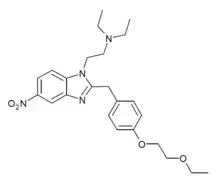 | |
| Identifiers | |
|---|---|
| |
| CAS Number | |
| PubChem CID | |
| UNII | |
| Chemical and physical data | |
| Formula | C24H32N4O4 |
| Molar mass | 440.544 g·mol−1 |
| 3D model (JSmol) | |
| |
| |
Etoetonitazene is a benzimidazole derivative with opioid effects, first developed in the 1950s as part of the research that led to better-known compounds such as etonitazene. It is an analogue of etonitazene where the ethoxy group has been extended to ethoxyethoxy. It is less potent than etonitazene itself, but is still a potent opioid agonist with around 50x the potency of morphine, and has been sold as a designer drug since around 2022.[1][2]
See also
References
- ↑ "A review of the evidence on the use and harms of 2-benzyl benzimidazole ('nitazene') and piperidine benzimidazolone ('brorphine-like') opioids" (PDF). UK: Advisory Council on the Misuse of Drugs. July 2022.
- ↑ Hasegawa K, Minakata K, Suzuki M, Suzuki O (July 2022). "Non-fentanyl-derived synthetic opioids emerging during recent years". Forensic Toxicology. 40 (2): 234–243. doi:10.1007/s11419-022-00624-y. PMC 9052731. PMID 36454418.
This article is issued from Wikipedia. The text is licensed under Creative Commons - Attribution - Sharealike. Additional terms may apply for the media files.